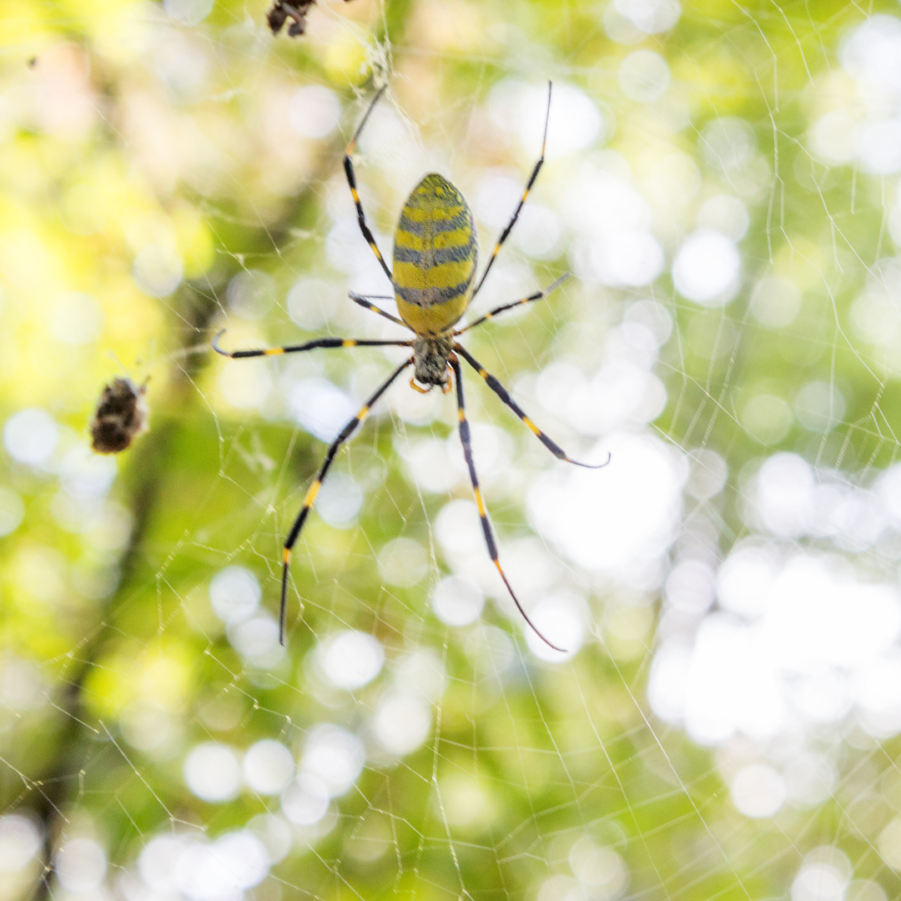Headlines about giant, flying spiders spreading across North America have become a trend over the last few summers. If you’ve come across these startling stories, you may have already heard about Joro spiders. These new arrivals to North America are causing quite a stir among nature enthusiasts and arachnophobes throughout the U.S. But are these giant spiders actually a problem? Let’s find out in this Naturalist Answers post.
What are joro spiders?
Joro spiders are large web-spinning spiders in the orb-weaver family, Araneidae. They are native to temperate regions of East Asia, including China, Korea, Taiwan, and warmer regions of Japan. Their English common name comes from their Japanese name, Jorō-gumo, and their scientific name is Trichonephila clavata. Joro spiders seem to prefer riverside environments in the native range in Asia. There, they feed on a variety of insect prey that they catch in their webs.
Want to learn more about animal families and orders? Check out this post!
How do you identify joro spiders?
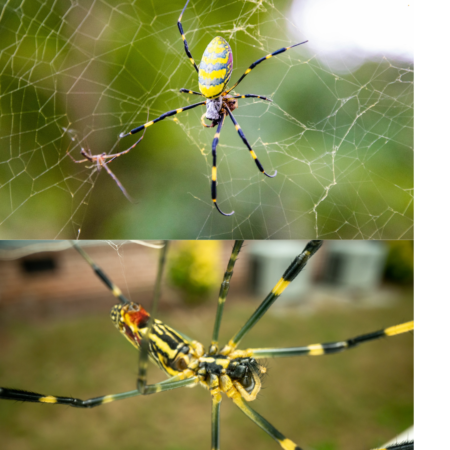
Joros hatch in early Spring each year, and are so small for much of their life cycle that they’re hard to notice. However, female joros grow quite large, and by late Summer and early Fall are hard to miss. They have black legs with orange stripes, a grey cephalothorax and an elongated, fat abdomen. Their abdomen has thick, yellow and blue-gray bands on the dorsal (back) side, and a reddish “box” on the belly side. Adult female joros can be up to 3 inches (8cm) across with their legs outstretched.
By contrast, males are comparatively miniscule. They often co-habitat with females in their webs, and may be confused with young. They might max out at an inch wide and are delicate, thin, and generally hard to notice. Most males remain very still, because too much movement will draw the nearby female’s attention, and put him on the menu!
Learn how to detect spongy moths, an invasive species in North America
Joro spiders make large, messy webs that consist of multiple, roughly circular “orbs”. Unlike many orbweaver spiders that take down their webs every day and make new ones every night, joros seem to maintain their web over time. Their huge webs can accumulate debris and can be several feet (1-2m) wide! Another distinctive feature of joro webs is that they often feature thick, tangled, golden threads in certain areas. These special threads are characteristic of their Araneidae family, and entomologists call them stabilimenta.
Do any native species look like joro spiders?
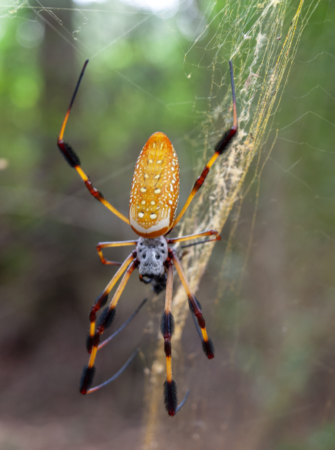
Importantly, joros have a native cousin here in the Americas to which they bear a family resemblance. The Golden silk orb weaver (Trichonephila clavipes), also known as the banana spider, occurs throughout most of Central and Northern South America year round. During the Summer, they show up as far North as Canada, and can be common in the American Southeast. Although very similar in shape and size to joros, they have a red-orange abdomen with speckles, rather than the bold stripes of the joro.
How did joro spiders get to North America?

Scientists generally believe that joro spiders arrived in North America similarly to many other introduced invertebrates. That is, probably by accident! Especially when they are small, joros and other spiders can easily slip beneath our attention. Arachnids like spiders are notorious for being able to survive long periods of time without food or water. As a result, young joros could easily have been “stowaways” in horticultural plants, in shipping containers, or even on ships themselves.
A couple of young joros is all it would take to start a new population outside of Asia, so long as they landed in a favorable habitat. Furthermore, young spiders are surprisingly mobile! They typically move around using a method called ballooning, where they release a strand of statically-charged silk from their abdomen. The silk is so light and thin that static electricity can pull it into the air. Together with wind currents, that can generate sufficient lift to pull the spiderlings’ r tiny bodies into their air. Baby spiders weigh next to nothing, so once they air airborne, they can quickly cover a lot of distance.
How do plants spread their seeds?
When did joro spiders arrive?
The first reports of joro spiders come from North Georgia starting around 2013-14. Experts consider this “ground zero” for the species’ establishment in the United States. Since then, scientists and nature-lovers have watched them rapidly expand across the Eastern seaboard.
Are they an invasive species?
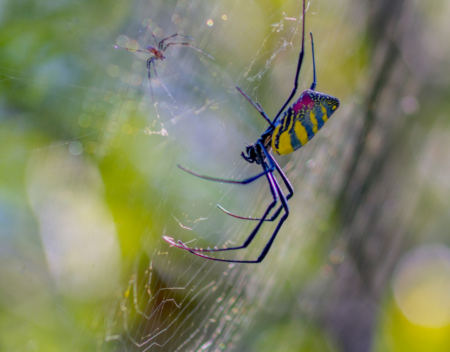
People are often concerned about invasive species, which are introduced or exotic organisms that cause damage to the environment. A question I get frequently while talking about joros on my nature walks is, “are joro spiders an invasive species?”. The technical answer to that question is not yet clear. While the joro is certainly an introduced species, the jury is still out on that one in one sense. Why is that, you ask?
Why are invasive species bad for the environment?
Declaring a species invasive requires that it satisfies certain criteria. Notably, it has to cause noticeable damage or disruption to the ecosystems to which it was introduced. There has so far been very little research on joros in the U.S., so we simply don’t know whether they should be considered an invasive species. In other words, we don’t have the strong evidence yet.
Is that enough reason to say that joros are harmless to the environment? No! Just because we haven’t looked into the problem doesn’t mean that there isn’t one yet. There is plenty of reason to be concerned about the joro’s arrival. These spiders display one key characteristic of an invasive species: booming population growth, associated with high densities and a rapidly expanding range.
Each year, there seem to be more joros in North Georgia where they first arrived, and I notice them further and further away when I travel for hikes. Many experts expect them to be turning up as far away as Southern New York in Summer 2024! This exploding population suggests that native predators like birds, lizards, and parasitoid wasps, as well as diseases, are not sufficient to control joro populations. You guessed it: booming, uncontrolled population growth free from such “natural enemies” is another hallmark of invasive species.
Considering that joros make massive webs in huge numbers all along rivers and lowland forests throughout their new home, it’s reasonable to guess they are affecting local wildlife populations. When their webs are biggest in the Fall here in Georgia, it seems hard to imagine any bug running the gauntlet through them all. On riverside strolls in some of my favorite outdoor spots, I’ll notice 10 or more webs with huge females along just 20 feet (~7m) of trail. With many insect populations declining across the globe, the arrival of the joro could pose an additional problem for our ecosystems.
Are joro spiders dangerous to people?
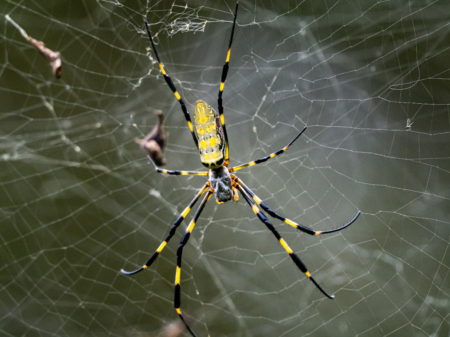
Generally speaking, joros are not a threat to people in any way. In my own experience handling them (sometimes on purpose, sometimes not!), I have found them slow-moving and gentle. Capturing them with tweezers for a preliminary research study in Georgia, I noticed that they rarely bite even in self defense. However, all spiders are venomous, and the joro is no exception. This means that joros can deliver a painful bite, which some people describe like a bee-sting in intensity.
What’s the difference between venomous and poisonous?
Researchers from the University of Georgia found that joros are unusually shy and will freeze for up to an hour if they feel threatened. To be clear: they’re A LOT more scared of you than you are of them. Of course, I understand if that’s hard to believe, considering how big and threatening the females look. This shy behavior and their reluctance to bite means that joro spiders are not dangerous to people. Folks with allergies to bee stings or other sensitivities to invertebrates should be cautious with them, however.
Are they dangerous to pets?
Joros usually build their webs fairly high up and out of reach of common pets like cats and dogs. Furthermore, they do not commonly enter houses. Their venom seems to affect other large mammals similarly to people. That is, it may cause some pain and discomfort for a while, but no serious effects. Alternatively, pets are not likely to eat a joro since they hide in strong, tangled webs that are difficult to navigate. If a pet should eat one for some reason, they are unlikely to be negatively affected.
Do joro spiders eat pests?
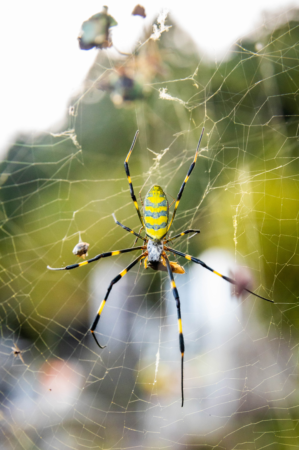
Some rather sensationalist articles about joros have even gone so far as to suggest that their arrival is a good thing. Although I understand wanting people not to be afraid of big spiders just because they are, well, big spiders, I think this may be a step too far. One entomologist commented that spiders like joros commonly consume crop pests, which certainly is a great service. Nature lovers on social media have also reported finding invasive pests like the brown marmorated stinkbugs and spotted lanternflies in their webs.
However, as with other mysteries around the joro, we still don’t have strong evidence showing that they can control pest populations. Beyond that, it’s also unclear whether any pest control benefits would outweigh the potential costs to our native insects and the vital roles they play in our ecosystems. It’s extremely important to remember that a comparably small number of insect species are pests; the vast majority play an essential role in making the Earth a livable planet. One 2023 study researching joro diets suggests that they eat a variety of invertebrates, especially including:
- Beetles (Coleoptera)
- True flies (Diptera)
- Bees and wasps (Hymenoptera)
Will joro spiders enter your home?
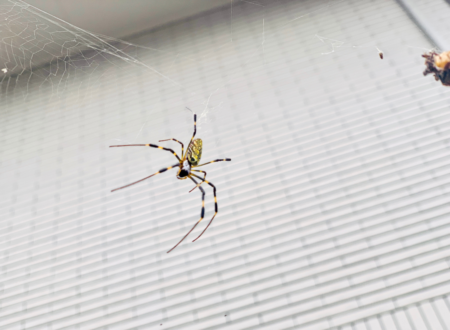
Living in North Georgia, around the epicenter of the joro spider “invasion”, I have had these animals all over the outside of my house. For years I’ve wondered if they would come inside, and they never, ever have. Not a single friend or acquaintance, nature-lover or not, has ever reported one making a web in their home. In my experience, they seem to exclusively build their webs outside. Joro spiders are extremely unlikely to enter your home, but are very likely to be a cozy neighbor. They may certainly build webs on porches, balconies, rooves, or other outdoor structures.
How far will they spread?
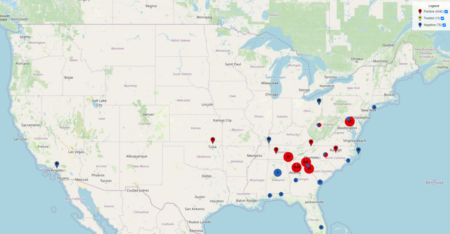
Many readers from other parts of North America have asked me whether they can expect joros to show up in their neighborhood. Since young spiders can spread so easily via ballooning, they will probably show up just about anywhere that they can survive. In the case of the joro, this probably means most of the Eastern seaboard, up until the point where winters get too harsh for them. Although it might take a few years, experts expect them to spread as far as the midwest and potentially as far North as Canada. To the South, they could very well reach the Northern edge of Mexico.
Interestingly, these very shy spiders have an easy time adapting to urban life. Joros show up in great numbers around houses and along electrical wires along roadsides. Some fantastic research at the University of Georgia showed that even in loud, busy areas they are capable of detecting and responding to prey. This means that joro spiders will absolutely be showing up in cities all over the Eastern half of the U.S. as they continue to spread every spring.
Thanks for reading!
If you enjoyed this post, please support the blog by sharing this post with friends. Follow Gulo in Nature on social media to get the latest from the blog. If you’ve got more nature related questions or content you’d like to see on the blog, get in touch using the Contact Page. We’d love to hear from you!

